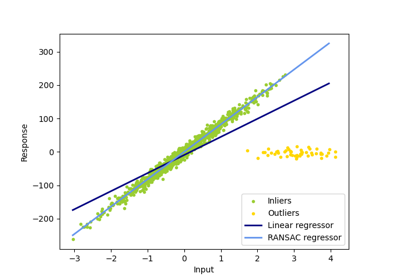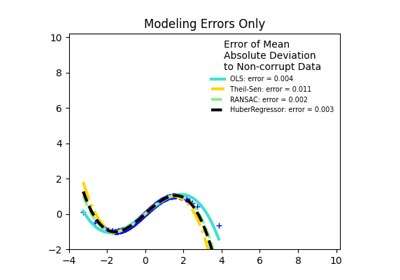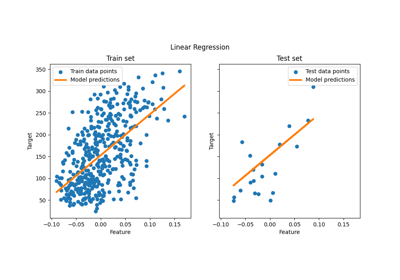备注
Go to the end 下载完整的示例代码。或者通过浏览器中的MysterLite或Binder运行此示例
Theil-Sen回归#
在合成数据集上计算Theil-Sen回归。
看到 Theil-Sen估计量:基于广义中位数的估计量 有关回归量的更多信息。
与OLS(普通最小平方)估计器相比,Theil-Sen估计器对异常值具有鲁棒性。在简单线性回归的情况下,它的崩溃点约为29.3%,这意味着在二维情况下,它可以容忍高达29.3%的任意损坏数据(离群值)。
模型的估计是通过计算p个子样本点的所有可能组合的子种群的斜坡和截取来完成的。如果截取已进行匹配,p必须大于或等于n_features + 1。然后将最终的斜坡和相交定义为这些斜坡和相交的空间中位数。
在某些情况下,Theil-Sen的表现优于 RANSAC 这也是一种稳健的方法。这在下面的第二个例子中得到了说明,其中相对于x轴的离群值扰动RASAC。调谐 residual_threshold RASAC的参数弥补了这一点,但一般来说,需要有关数据和异常值性质的先验知识。由于Theil-Sen的计算复杂性,建议仅将其用于样本数量和特征方面的小问题。对于更大的问题, max_subpopulation 参数将p个子样本点的所有可能组合的幅度限制为随机选择的子集,因此也限制了运行时间。因此,Theil-Sen适用于更大的问题,但缺点是失去了一些数学性质,因为它适用于随机子集。
# Authors: The scikit-learn developers
# SPDX-License-Identifier: BSD-3-Clause
import time
import matplotlib.pyplot as plt
import numpy as np
from sklearn.linear_model import LinearRegression, RANSACRegressor, TheilSenRegressor
estimators = [
("OLS", LinearRegression()),
("Theil-Sen", TheilSenRegressor(random_state=42)),
("RANSAC", RANSACRegressor(random_state=42)),
]
colors = {"OLS": "turquoise", "Theil-Sen": "gold", "RANSAC": "lightgreen"}
lw = 2
仅在y方向上存在离群值#
np.random.seed(0)
n_samples = 200
# Linear model y = 3*x + N(2, 0.1**2)
x = np.random.randn(n_samples)
w = 3.0
c = 2.0
noise = 0.1 * np.random.randn(n_samples)
y = w * x + c + noise
# 10% outliers
y[-20:] += -20 * x[-20:]
X = x[:, np.newaxis]
plt.scatter(x, y, color="indigo", marker="x", s=40)
line_x = np.array([-3, 3])
for name, estimator in estimators:
t0 = time.time()
estimator.fit(X, y)
elapsed_time = time.time() - t0
y_pred = estimator.predict(line_x.reshape(2, 1))
plt.plot(
line_x,
y_pred,
color=colors[name],
linewidth=lw,
label="%s (fit time: %.2fs)" % (name, elapsed_time),
)
plt.axis("tight")
plt.legend(loc="upper right")
_ = plt.title("Corrupt y")
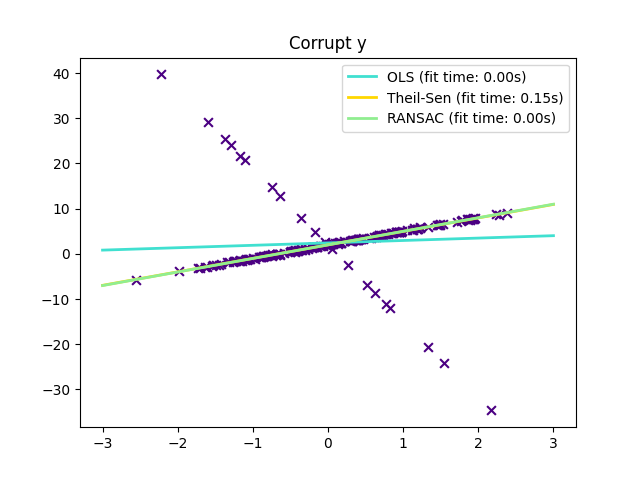
X方向的离群值#
np.random.seed(0)
# Linear model y = 3*x + N(2, 0.1**2)
x = np.random.randn(n_samples)
noise = 0.1 * np.random.randn(n_samples)
y = 3 * x + 2 + noise
# 10% outliers
x[-20:] = 9.9
y[-20:] += 22
X = x[:, np.newaxis]
plt.figure()
plt.scatter(x, y, color="indigo", marker="x", s=40)
line_x = np.array([-3, 10])
for name, estimator in estimators:
t0 = time.time()
estimator.fit(X, y)
elapsed_time = time.time() - t0
y_pred = estimator.predict(line_x.reshape(2, 1))
plt.plot(
line_x,
y_pred,
color=colors[name],
linewidth=lw,
label="%s (fit time: %.2fs)" % (name, elapsed_time),
)
plt.axis("tight")
plt.legend(loc="upper left")
plt.title("Corrupt x")
plt.show()
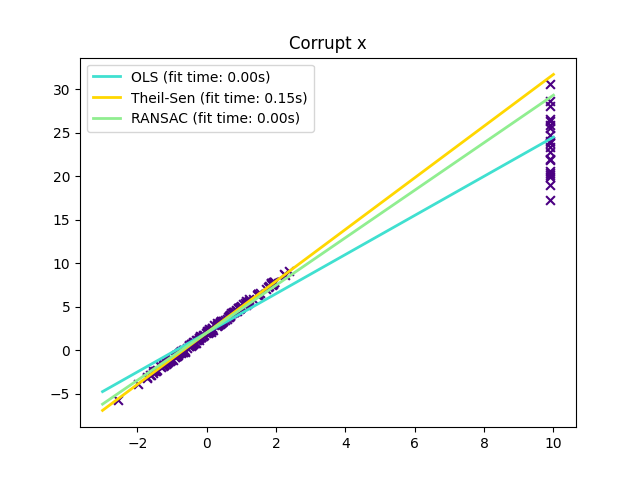
Total running time of the script: (0分0.422秒)
相关实例
Gallery generated by Sphinx-Gallery <https://sphinx-gallery.github.io> _

